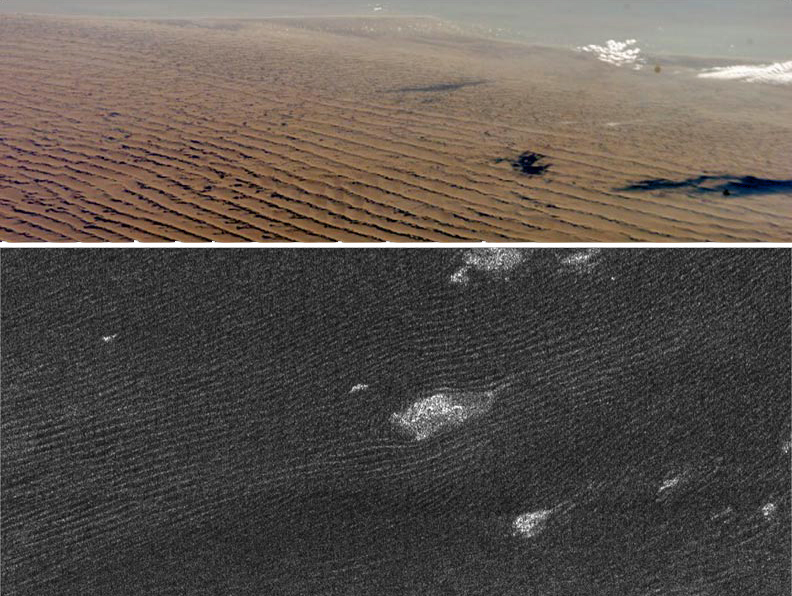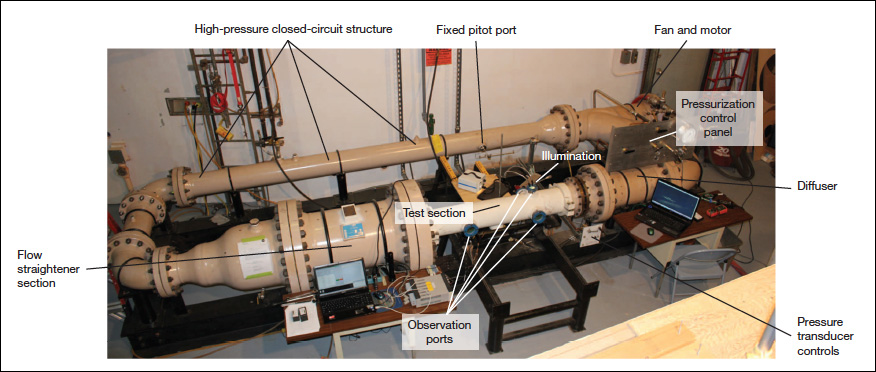Using a specially engineered wind tunnel scientists have discovered how wind-blown dunes form on Titan – Saturn’s largest moon.
Titan has dunes that are hundreds of feet high and hundreds of miles long. The formation of these dunes has puzzled scientists for years.
Titan has dense hydrocarbon lakes filled with methane and ethane and it is thought to be one of the only bodies in our solar system (along with Mars, Venus, and Earth) to contain wind-blown dunes.
However, according to two separate studies published Monday in the journal Nature, the dunes on Titan are completely different to the ones found on Earth or Mars – which are composed largely of silicates.
The Cassini orbiter has been monitoring Saturn for over ten years now. The research team used data the orbiter collected.
What they found is that the dunes on Titan are composed of hydrocarbons and “may possibly include particles of water ice that are coated with these organic materials.”
The researchers said in a statement:
“The team found that the threshold — or minimum — wind speed needed to transport Titan’s hydrocarbon-rich sand was higher than typical for the prevailing winds on that moon,”

Cassini radar sees sand dunes in Belet (a dark equatorial albedo feature) on Saturn’s giant moon Titan (lower photo) that are sculpted like Namibian sand dunes on Earth (upper photo).
The greater wind speed on Titan explains the mystery of the dunes’ alignment. The winds on the moon sometimes reverse direction and significantly increase in intensity because of the changing position of the Sun. Only stronger winds blowing from the west can move the sand and streamline the dunes because the threshold wind speed is so high. These shifting winds are responsible for the formation of the dunes.
Devon Burr, a planetary scientist from the University of Tennessee who used to work at the SETI (Search for Extra-Terrestrial Intelligence) Institute, led the research team.
They used a high-pressure wind tunnel to simulate Titan’s wind conditions and found that the necessary wind speed for forming hydrocarbon-laden sand dunes on the moon was about 50 percent higher than previous estimates.

Titan wind tunnel with important components labelled. Source: SETI Institute.
The wind tunnel was made in the 1980s for modeling aeolian physics on Venus, notes co-author John Marshall of the SETI Institute.
“It was a bear to operate, but Dr. Burr’s refurbishment of the facility as a Titan simulator has tamed the beast. It is now an important addition to NASA’s arsenal of planetary simulation facilities.”
Burr said:
“How this strange alien sand got there is still unknown, but even more baffling is the direction of the winds that create the dunes. Our models started with previous wind speed models but we had to keep tweaking them to match the wind tunnel data. We discovered that movement of sand on Titan’s surface needed a wind speed that was higher than what previous models suggested.”
Burr believes that the results could also have down-to-Earth applications:
“We see today sediment being wafted over the Sahara desert, across the Atlantic to South America. This wind-blow material accounts for much of the fertility of the Amazon Basin. So understanding this process is essential.”
Reference
“Higher-than-predicted saltation threshold wind speeds on Titan” Nature (2014) doi:10.1038/nature14088
Authors: Devon M. Burr, Nathan T. Bridges, John R. Marshall, James K. Smith, Bruce R. White & Joshua P. Emery
